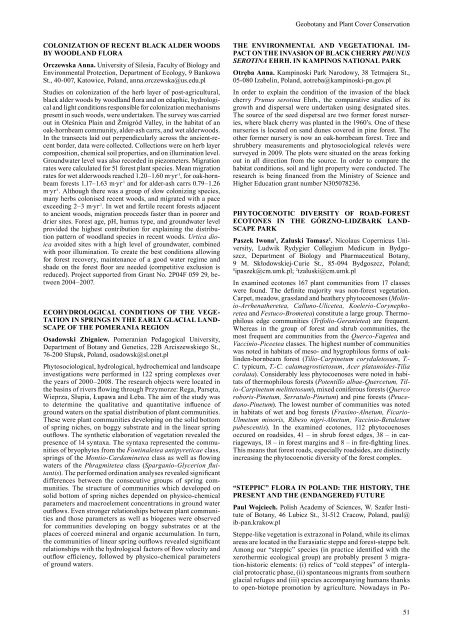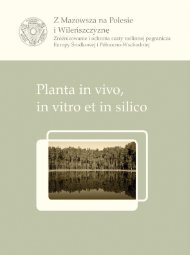acta societatis botanicorum poloniae - LV Zjazd Polskiego ...
acta societatis botanicorum poloniae - LV Zjazd Polskiego ...
acta societatis botanicorum poloniae - LV Zjazd Polskiego ...
You also want an ePaper? Increase the reach of your titles
YUMPU automatically turns print PDFs into web optimized ePapers that Google loves.
COLONIZATION OF rECENT BLACK ALdEr WOOdS<br />
BY WOOdLANd FLOrA<br />
Orczewska Anna. University of Silesia, Faculty of Biology and<br />
Environmental Protection, Department of Ecology, 9 Bankowa<br />
St., 40-007, Katowice, Poland, anna.orczewska@us.edu.pl<br />
Studies on colonization of the herb layer of post-agricultural,<br />
black alder woods by woodland flora and on edaphic, hydrological<br />
and light conditions responsible for colonization mechanisms<br />
present in such woods, were undertaken. The survey was carried<br />
out in Oleśnica Plain and Żmigród Valley, in the habitat of an<br />
oak-hornbeam community, alder-ash carrs, and wet alderwoods.<br />
In the transects laid out perpendicularly across the ancient-recent<br />
border, data were collected. Collections were on herb layer<br />
composition, chemical soil properties, and on illumination level.<br />
Groundwater level was also recorded in piezometers. Migration<br />
rates were calculated for 51 forest plant species. Mean migration<br />
rates for wet alderwoods reached 1.20– 1.60 m∙yr -1 , for oak-hornbeam<br />
forests 1.17– 1.63 m∙yr -1 and for alder-ash carrs 0.79– 1.26<br />
m∙yr -1 . Although there was a group of slow colonizing species,<br />
many herbs colonised recent woods, and migrated with a pace<br />
exceeding 2– 3 m∙yr -1 . In wet and fertile recent forests adjacent<br />
to ancient woods, migration proceeds faster than in poorer and<br />
drier sites. Forest age, pH, humus type, and groundwater level<br />
provided the highest contribution for explaining the distribution<br />
pattern of woodland species in recent woods. Urtica dioica<br />
avoided sites with a high level of groundwater, combined<br />
with poor illumination. To create the best conditions allowing<br />
for forest recovery, maintenance of a good water regime and<br />
shade on the forest floor are needed (competitive exclusion is<br />
reduced). Project supported from Grant No. 2P04F 059 29, between<br />
2004– 2007.<br />
ECOHYdrOLOGICAL CONdITIONS OF THE VEGE-<br />
TATION IN SPrINGS IN THE EArLY GLACIAL LANd-<br />
SCAPE OF THE POMErANIA rEGION<br />
Osadowski Zbigniew. Pomeranian Pedagogical University,<br />
Department of Botany and Genetics, 22B Arciszewskiego St.,<br />
76-200 Słupsk, Poland, osadowsk@sl.onet.pl<br />
Phytosociological, hydrological, hydrochemical and landscape<br />
investigations were performed in 122 spring complexes over<br />
the years of 2000– 2008. The research objects were located in<br />
the basins of rivers flowing through Przymorze: Rega, Parsęta,<br />
Wieprza, Słupia, Łupawa and Łeba. The aim of the study was<br />
to determine the qualitative and quantitative influence of<br />
ground waters on the spatial distribution of plant communities.<br />
These were plant communities developing on the solid bottom<br />
of spring niches, on boggy substrate and in the linear spring<br />
outflows. The synthetic elaboration of vegetation revealed the<br />
presence of 14 syntaxa. The syntaxa represented the communities<br />
of bryophytes from the Fontinaletea antipyreticae class,<br />
springs of the Montio-Cardaminetea class as well as flowing<br />
waters of the Phragmitetea class (Sparganio-Glycerion fluitantis).<br />
The performed ordination analyses revealed significant<br />
differences between the consecutive groups of spring communities.<br />
The structure of communities which developed on<br />
solid bottom of spring niches depended on physico-chemical<br />
parameters and macroelement concentrations in ground water<br />
outflows. Even stronger relationships between plant communities<br />
and those parameters as well as biogenes were observed<br />
for communities developing on boggy substrates or at the<br />
places of coerced mineral and organic accumulation. In turn,<br />
the communities of linear spring outflows revealed significant<br />
relationships with the hydrological factors of flow velocity and<br />
outflow efficiency, followed by physico-chemical parameters<br />
of ground waters.<br />
Geobotany and Plant Cover Conservation<br />
THE ENVIrONMENTAL ANd VEGETATIONAL IM-<br />
PACT ON THE INVASION OF BLACK CHErrY Prunus<br />
serotinA EHrH. IN KAMPINOS NATIONAL PArK<br />
otręba Anna. Kampinoski Park Narodowy, 38 Tetmajera St.,<br />
05-080 Izabelin, Poland, aotreba@kampinoski-pn.gov.pl<br />
In order to explain the condition of the invasion of the black<br />
cherry Prunus serotina Ehrh., the comparative studies of its<br />
growth and dispersal were undertaken using designated sites.<br />
The source of the seed dispersal are two former forest nurseries,<br />
where black cherry was planted in the 1960’s. One of these<br />
nurseries is located on sand dunes covered in pine forest. The<br />
other former nursery is now an oak-hornbeam forest. Tree and<br />
shrubbery measurements and phytosociological relevés were<br />
surveyed in 2009. The plots were situated on the areas forking<br />
out in all direction from the source. In order to compare the<br />
habitat conditions, soil and light property were conducted. The<br />
research is being financed from the Ministry of Science and<br />
Higher Education grant number N305078236.<br />
PHYTOCOENOTIC dIVErSITY OF rOAd-FOrEST<br />
ECotoNES IN tHE GóRZNo-LIDZBARK LAND-<br />
SCAPE PArK<br />
Paszek Iwona 1 , Załuski tomasz 2 . Nicolaus Copernicus University,<br />
Ludwik Rydygier Collegium Medicum in Bydgoszcz,<br />
Department of Biology and Pharmaceutical Botany,<br />
9 M. Skłodowskiej-Curie St., 85-094 Bydgoszcz, Poland;<br />
1 ipaszek@cm.umk.pl; 2 tzaluski@cm.umk.pl<br />
In examined ecotones 167 plant communities from 17 classes<br />
were found. The definite majority was non-forest vegetation.<br />
Carpet, meadow, grassland and heathery phytocoenoses (Molinio-Arrhenatheretea,<br />
Calluno-Ulicetea, Koelerio-Corynephoretea<br />
and Festuco-Brometea) constitute a large group. Thermophilous<br />
edge communities (Trifolio-Geranietea) are frequent.<br />
Whereas in the group of forest and shrub communities, the<br />
most frequent are communities from the Querco-Fagetea and<br />
Vaccinio-Piceetea classes. The highest number of communities<br />
was noted in habitats of meso- and hygrophilous forms of oaklinden-hornbeam<br />
forest (Tilio-Carpinetum corydaletosum, T.-<br />
C. typicum, T.-C. calamagrostietosum, Acer platanoides-Tilia<br />
cordata). Considerably less phytocoenoses were noted in habitats<br />
of thermophilous forests (Potentillo albae-Quercetum, Tilio-Carpinetum<br />
melittetosum), mixed coniferous forests (Querco<br />
roboris-Pinetum, Serratulo-Pinetum) and pine forests (Peucedano-Pinetum).<br />
The lowest number of communities was noted<br />
in habitats of wet and bog forests (Fraxino-Alnetum, Ficario-<br />
Ulmetum minoris, Ribeso nigri-Alnetum, Vaccinio-Betuletum<br />
pubescentis). In the examined ecotones, 112 phytocoenoses<br />
occured on roadsides, 41 – in shrub forest edges, 38 – in carriageways,<br />
18 – in forest margins and 8 – in fire-fighting lines.<br />
This means that forest roads, especially roadsides, are distinctly<br />
increasing the phytocoenotic diversity of the forest complex.<br />
“STEPPIC” FLOrA IN POLANd: THE HISTOrY, THE<br />
PrESENT ANd THE (ENdANGErEd) FUTUrE<br />
Paul Wojciech. Polish Academy of Sciences, W. Szafer Institute<br />
of Botany, 46 Lubicz St., 31-512 Cracow, Poland, paul@<br />
ib-pan.krakow.pl<br />
Steppe-like vegetation is extrazonal in Poland, while its climax<br />
areas are located in the Eurasiatic steppe and forest-steppe belt.<br />
Among our “steppic” species (in practice identified with the<br />
xerothermic ecological group) are probably present 3 migration-historic<br />
elements: (i) relics of “cold steppes” of interglacial<br />
protocratic phase, (ii) spontaneous migrants from southern<br />
glacial refuges and (iii) species accompanying humans thanks<br />
to open-biotope promotion by agriculture. Nowadays in Po-<br />
51



